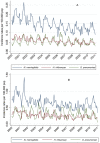Bacterial Meningitis in Brazil: Baseline Epidemiologic Assessment of the Decade Prior to the Introduction of Pneumococcal and Meningococcal Vaccines
- PMID: 23823579
- PMCID: PMC3688798
- DOI: 10.1371/journal.pone.0064524
Bacterial Meningitis in Brazil: Baseline Epidemiologic Assessment of the Decade Prior to the Introduction of Pneumococcal and Meningococcal Vaccines
Abstract
Background: Bacterial meningitis is associated with significant burden in Brazil. In 2010, both 10-valent pneumococcal conjugate vaccine and meningococcal capsular group C conjugate vaccine were introduced into the routine vaccination schedule. Haemophilus influenzae type b vaccine was previously introduced in 1999. This study presents trends in demographics, microbiological characteristics and seasonality patterns of bacterial meningitis cases in Brazil from 2000 to 2010.
Methods and findings: All meningitis cases confirmed by clinical and/or laboratory criteria notified to the national information system for notifiable diseases between 2000 and 2010 were analyzed. Proportions of bacterial meningitis cases by demographic characteristics, criteria used for confirmation and etiology were calculated. We estimated disease rates per 100,000 population and trends for the study period, with emphasis on H. influenzae, N. meningitidis and S. pneumoniae cases. In the decade, 341,805 cases of meningitis were notified in Brazil. Of the 251,853 cases with defined etiology, 110,264 (43.8%) were due to bacterial meningitis (excluding tuberculosis). Of these, 34,997 (31.7%) were due to meningococcal disease. The incidence of bacterial meningitis significantly decreased from 3.1/100,000 population in 2000-2002 to 2.14/100,000 in 2009-2010 (p<0.01). Among cases of meningococcal disease, the proportion of those associated with group C increased from 41% in 2007 to 61.7% in 2010, while the proportion of group B disease progressively declined. Throughout the study period, an increased number of cases occurred during winter.
Conclusions: Despite the reduction in bacterial meningitis incidence during the last decade, it remains a significant healthcare issue in Brazil. Meningococcal disease is responsible for the majority of the cases with group C the most common capsular type. Our study demonstrates the appropriateness of introduction of meningococcal vaccination in Brazil. Furthermore, this study provides a baseline for future evaluation of the impact of the vaccines introduction in Brazil and changes in disease epidemiology.
Conflict of interest statement
Figures




References
-
- Brasil, Ministério da Saúde (2012) O que é o Sinan. Brasília.
-
- Brasil, Ministério da Saúde (2009) Guia de Vigilancia Epidemiológica. Brasilia.
-
- Escosteguy CC, Medronho R deA, Madruga R, Dias HG, Braga RC, et al. (2004) [Epidemiologic surveillance and evaluation of meningitis hospital care]. Rev Saude Publica 38: 657–663. - PubMed
-
- Figueira GCNC, Carvalhanas TRMP, Okai MIG, Yu ALF, Liphaus BL (2012) Avaliação do sistema de vigilância das meningites no município de São Paulo, com ênfase para doença meningocócica. Boletim Epidemiologico Paulista 9: 5–25.
-
- World Health Organization (2003) WHO–recommended standards for surveillance of selected vaccine-preventable diseases. In: Department of Vaccines and Biologicals, editor: World Health Organization.
Publication types
MeSH terms
Substances
LinkOut - more resources
Full Text Sources
Other Literature Sources

